I’ve been hearing a lot about Olight flashlights in the past two years, but I wondered if the flashlights lived up to the hype. After all, there are a number of factories around the world that can turn out inexpensive lights. But one question remains:
Will the flashlight work when your life is in danger?
That’s a pretty big question and an even bigger standard to meet. Since the cost of failure could be your life, a cheap flashlight is no bargain.
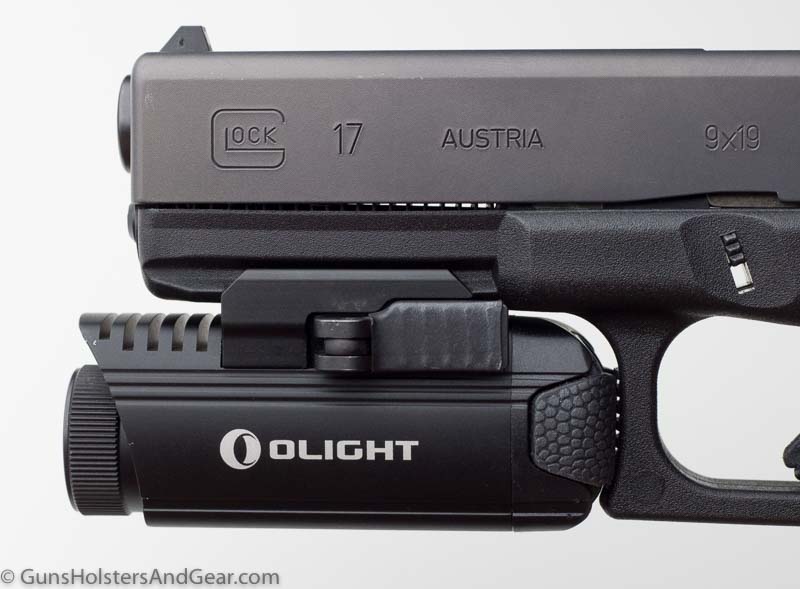
Yet, a number of firearms instructors I respect seem to like the Olight products. So, when Olight contacted me about testing the company’s new PL-1 II Valkyrie weapon light, I decided to take them up on the offer.
Quick Takeaways
– bright, flood-type light without artifacts
– fast and secure mount
– good run time and reasonably durable
– may not fit on some compact pistols
– can be purchased through our affiliate link
As you can see in the table of contents, I don’t fool around when testing flashlights. All of the opinions expressed here are my own, and your opinions may vary. I encourage everyone to share their experiences with this flashlight, or Olight in general, in the comments below.
General Information
Olight is a flashlight manufacturer that offers a range of lighting products. It markets its products for outdoors, emergency preparedness, self-defense, search & rescue, tactical and law enforcement use. When a company markets to these groups, there is an unstated suggestion that the flashlights are ready for use in critical, life-threatening situations.
The subject of this review is the PL-1 II Valkyrie. The Valkyrie is a weapon mountable flashlight that offers three modes of use: momentary-on, constant on and strobe. The unit is relatively lightweight and has a quick attach latch that allows you to mount it to a Glock or Picatinny accessory rail.
A “II” in the model name suggest the obvious: this is an upgrade to the original PL-1 Valkyrie.
A Question of Specifications
In previous reviews, I have stated my concerns about how the flashlight industry reports measured performance of a flashlight.
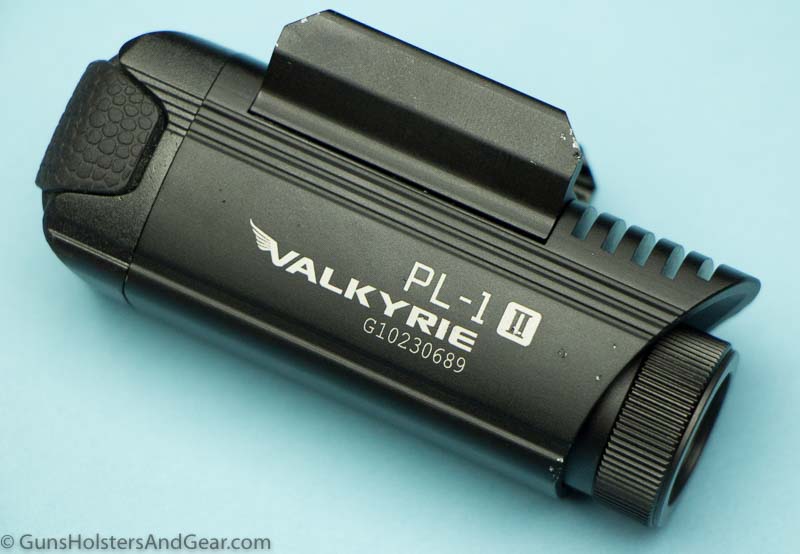
A voluntary performance standard was adopted in 2009. This standard, the FL 1-2009 Flashlight Basic Performance Standard, lays out how manufacturers should test their lights and how that information should be reported to consumers. The standard is maintained by PLATO, the Portable Lights American Trade Organization. Member organizations include Streamlight, Surefire, ASP, 5.11, Klarus, Panasonic and others.
While a good first step, the FL 1-2009 standard is, in my opinion, flawed and can be gamed. Additionally, since the standard is voluntary, a manufacturer can choose not to follow the testing and reporting protocols and display misleading or false information with few repercussions.
(Ed. note: As this review was being written, PLATO announced a revision to the standard. Once I’ve reviewed this standard, I will update the flashlight review page to indicate what changes are now in place.)
I found no reference to the FL 1 standard on the PL-1 II Valkyrie packaging, so I checked the company’s website and found that it does state:
ALL OLIGHT PRODUCTS ARE TESTED TO ANSI/NEMA FL1-2009 STANDARDS.
I confirmed with the company’s representative that Olight adheres to the FL 1 standard.
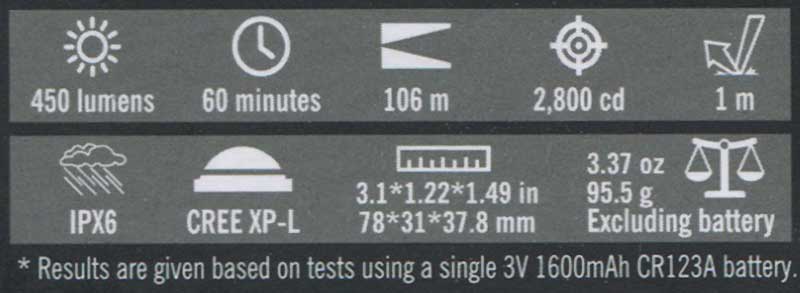
Unfortunately, Olight displays performance specifications on its packaging that don’t appear to comply with the requirements of the standard. Since the company appears to have eschewed the standardized information display, it created a question in my mind regarding how closely the company followed the testing procedures.
Company Provided Specs
The following specifications are provided by Olight on the Valkyrie’s packaging.
| Total Light Output | 450 lumens |
| Peak Beam Intensity | 2,800 candelas |
| Beam Distance | 106 meters |
| Runtime | 1 hour |
| Impact Resistance | 1 meter |
| Water Resistance | IPX6 (weather only, not submersible) |
| Weight (without battery) | 3.4 oz |
| Length | 3.1″ |
A quick overview of what some of the information above means:
- light output: total amount of emitted light without respect to the shape of the beams; measured in lumens
- peak beam intensity: maximum intensity of the brightest part of the beam measured in candela; typically flashlights with a tight, spot-style beam will measure higher than lights with flood-style beam but an equal number of lumens
- beam distance: the distance at which the flashlight can still provide lighting equal to a full moon (0.25 lux); measured in meters
- water resistance: measured to ANSI/IEC 60529 standard and expressed as an IP number (ex. IPX6 or IPX8); can be splash/weather resistant or submersible
- impact resistance: ability of the light to resist falling and striking cured concrete on six sides; expressed in meters
I measured the weight of the light with the included CR123A battery to be 3.8 ounces.
Warranty
Olight offers a five-year warranty against manufacturer defects. The written warranty specifically excludes “obvious user wear.” Additionally, the company states “Accessories such as pocket clips, holsters, and charging cables are not under the 5 year warranty.”
The Olight representative stated the company would back a light that was dropped at a distance not exceeding its stated impact resistance measurement.
Testing
Glance around the internet and you will find a lot of “reviews” done by people that have either used the flashlights very briefly or who have never touched them at all. I go the opposite way and use the flashlights as they are intended to be used. The dings on the light shown in the photos on this page clearly indicate I did not baby this light.
The Olight PL-1 II Valkarie is a flashlight that was specifically designed to be mounted to a firearm and is marketed as a tactical and law enforcement tool. Since these are unforgiving applications with serious consequences for failure, I evaluated this light from that perspective.
On the Range
For the range test, I selected a third generation Glock 17 to pair with the light. The Valkyrie mounted easily to the Glock’s frame and locked solidly into place.
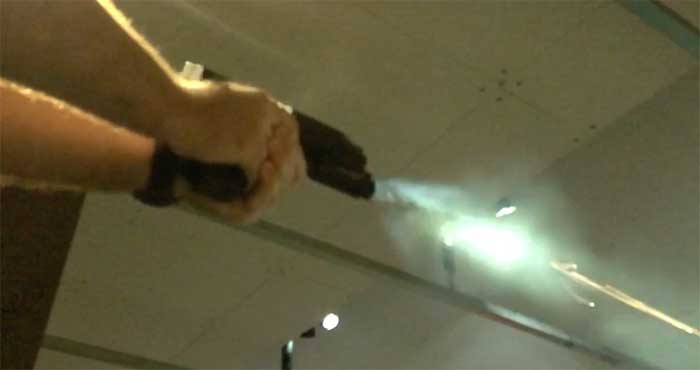
The quick attach/release lever on the Olight is vastly superior to the other weapon lights I’ve used in the past. It’s quick and has no play once locked on. I cannot overstate how much I like the mounting system.
For the initial testing, I ran 200 rounds through the Glock with the Valkyrie mounted. The ammunition I used was all self-defense or law enforcement ammunition. I fired 50 rounds of each of the following:
- Liberty Ammunition Civil Defense 50 gr HP +P
- Federal BPLE 115 gr +P+
- Federal HST 124 gr +P
- Winchester PDX1 147 gr
My Glock 17 is 100% reliable with all of these loads, so I wanted to see if the light would:
- withstand shooting full power loads and
- introduce any errors into the function of the G17.
Happily, the light functioned as well on the last shot as it did on the first. Also, the Glock had no malfunctions.
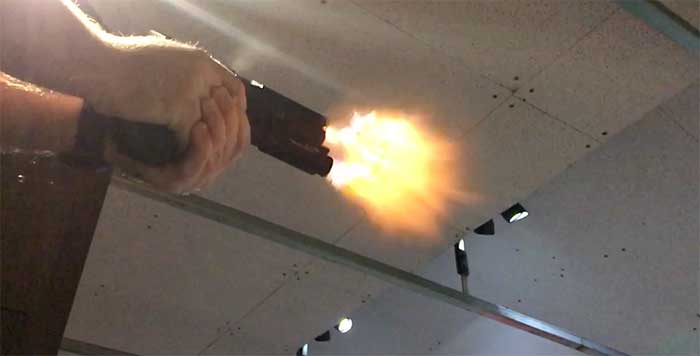
Since that initial test, I’ve since run about 2,000 rounds of various ammo loads through a range of guns that had the Olight Valkyrie attached. I’ve found no problems with the light or the guns when the light was attached.
Reach and Controls
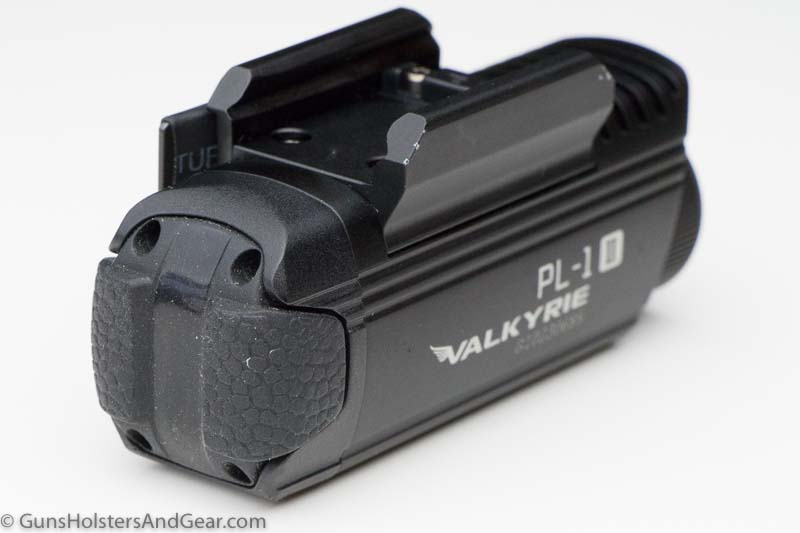
If I have any significant complaints about the Valkyrie weapon light, it is with the control interface. Specifically:
- I found the light’s switches tended to be at the extreme range of my hand’s reach.
- The activation and mode controls were less than ideal.
switch location: The light’s pressure switches are pretty far forward and that sometimes affected my ability to access them easily. Any activation of the light must be handled with my support hand. For me, at least, one-handed operation of the gun and light is not feasible as my trigger finger simply could not reach the activation switch without breaking my grip.
Switch locations are at the back end of the light putting them just forward of the trigger guard. On a pistol more compact than the Glock 17, the switches may be easier to reach.
activation and mode control: For me the design of the controls is less than ideal. A momentary press activates the light into a constant-on mode. If you are trying to quickly illuminate an area with just a flash, you often wind up turning the flashlight on in constant mode. That can be bad juju.
To get a momentary flash of light, you have to press and hold for a moment. I was never able to get the timing perfected to reliably activate the momentary-on for just a brief period of time. Maybe others can get it down, but it seems to be a flaw in the design.
If you want to activate the strobe mode, you have to press both buttons at the same time. In other words, I had to remove my supprt hand from the gun and then pinch the activation pads on the light. The strobe function simply cannot be used in a momentary-on mode.
Gun Fits
To fit the accessory rails made to both Glock and Picatinny standards, Olight includes a swappable key that screws into the top of the mount. Mu Valkyrie came with the Glock key installed. As expected, it fit the Glock 17 (Gen3) without any issues. I also checked it on a Gen4 Glock 19, and the fit was also perfect.
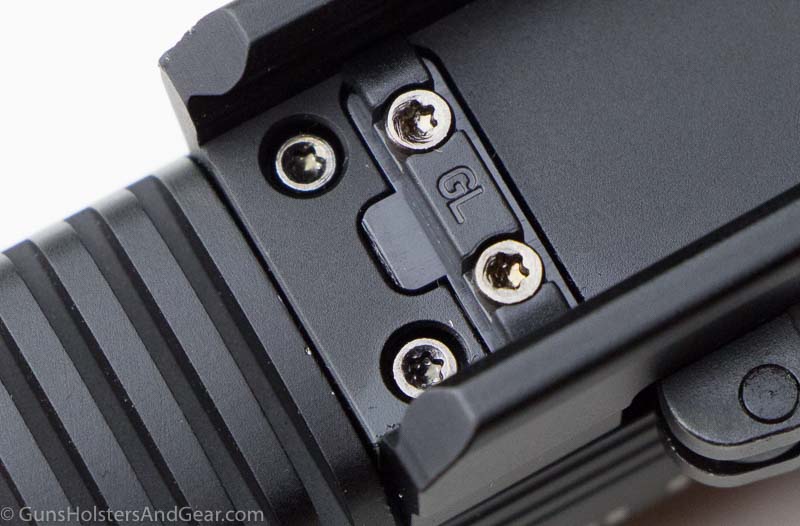
Using an included Torx driver, I swapped out the rail key and tried the light on other pistols. With full-size guns, the Olight Valkyrie was a good fit across the board. With some of the compact pistols, however, the light would not fit.
Checking five pistols I had at hand, I found the following guns were a good fit with the weapon light: CZ P-07, Smith & Wesson SD40 and Walther Creed. These two pistols did not have rails long enough to accommodate the Valkyrie: Bersa BP9CC and the Ruger American Compact pistol. As the Bersa is the same size as the BP380CC and BP40CC, I would not expect the light to fit on those guns either.
Output Over Time
If you have the equipment, light output is an easy thing to measure. Unfortunately, it is also an easy thing to manipulate and provide a false sense of a flashlight’s performance.
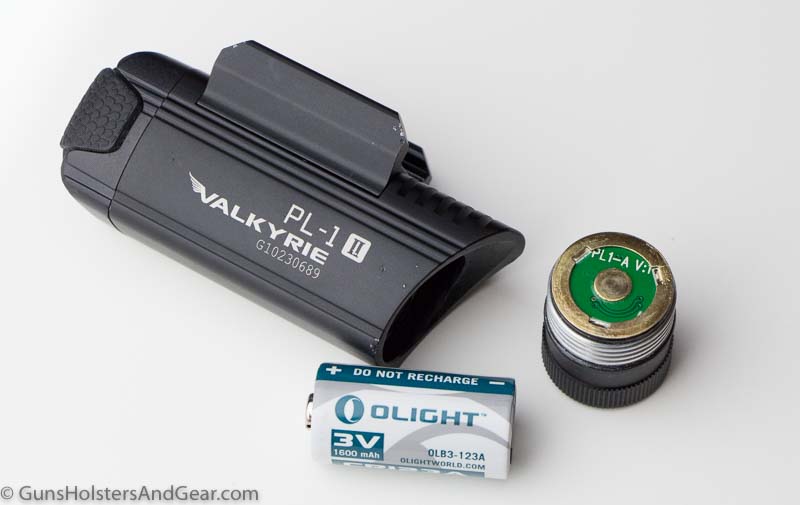
Even when using the FL 1 standard, it is easy for a company to boost a light’s initial output to record a high peak output and then string it along at maybe just 20% of the peak output to make it look like it has a long run time.
This kind of manipulation can create a false impression of the light’s capabilities. Trust me – there are some companies that play with the numbers to confuse the buyer. Fortunately, it doesn’t look like Olight is one of those.
In an effort to show the actual performance of a light, I created my own integrating sphere to record output over time. The sphere cannot measure absolute output, but it can show how well a flashlight maintains its output as time progresses.
The Olight PL-1 II Valkyrie lists an output of 450 lumens and a run time of one hour. Using a fresh Streamlight CR-123A battery, I recorded the following output:
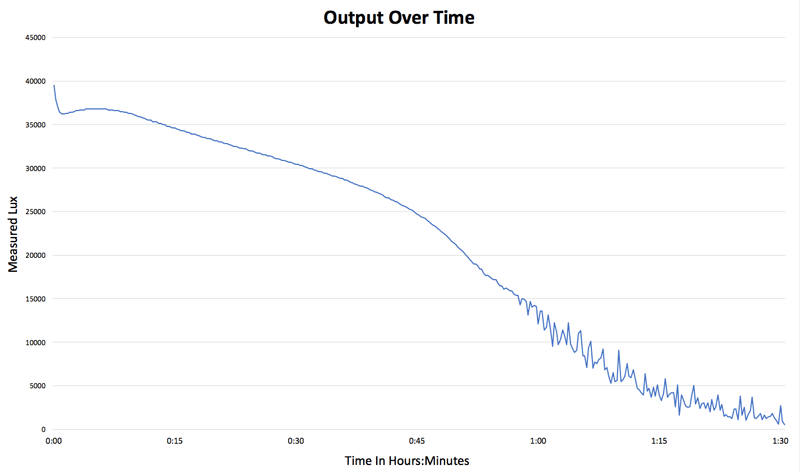
As you can see, the peak output drops sharply at the start of the graph, then slowly rolls down. Runtime, as measured by the FL 1 standard, is the total time from the peak output (recorded between the 30 second and 2 minute mark) until output reaches just 10% of the peak.
Based on my testing, the runtime to 10% was 1 hour 14 minutes – well in excess of the published 60 minutes. In other words, the Valkyrie’s performance seems to have exceeded its published specification.
I prefer to use a runtime to 50% of peak output as an indication of how much useful light you can expect from the light before changing the batteries. After all, who wants to clear a building with a light that is only throwing 20% of its output?
The 50% runtime was also very good for the Valkyrie. I measured this time to be 52 minutes, which is nearly the runtime given on the box.
Subjectively, I could notice a sizable drop in power around the 30 minute mark. However, the light was still bright enough for its intended purpose.
Overall, I’d say the Olight did very well with the design of this light’s output.
Heat Generation
Heat generation can be an issue in high-output flashlights. Generally, the brighter the light, the hotter the light becomes during operation. This can be mitigated through the use of more efficient electronics and physical design of the light’s case.
The top of the Valkyrie’s case has a few fins that appear to be designed for heat dissipation. I don’t know how effective they were, but I do know this light got very hot to the touch. Using an Etekcity infrared thermometer, I measured the peak surface temperature at 141.6° F. This is one of the hottest measurements on a weaponlight that I have observed in my flashlight testing.
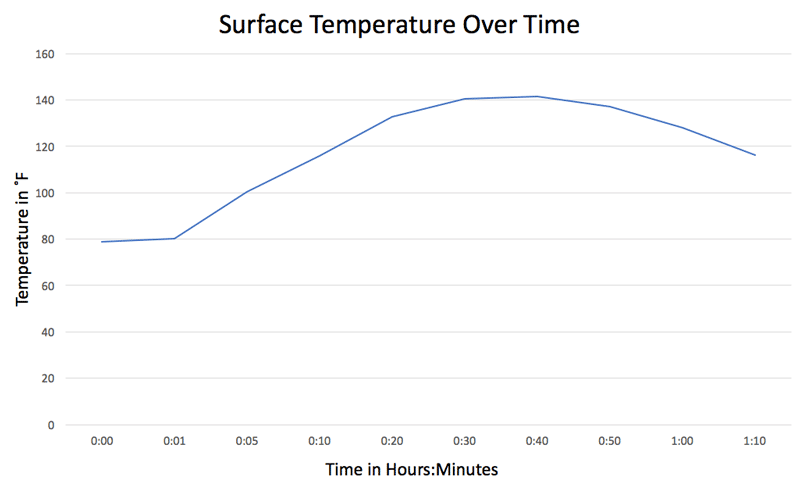
One would assume that the flashlight would not be left on continuously for 30+ minutes, but it will get very hot if you do.
Visual Comparison
The Valkyrie’s beam shape is generally a flood with a defined center and ample periphery light. There are no dark spots or artifacts in the beam as one might see with an older incandescent light.
The below photo comparison is between two photos taken with identical camera settings (ISO 400, f 8.0, 2.0 seconds). The first is a control photo without any external lighting. The second is with the Valkyrie activated. Use the slider to move back and forth to see how much light the Valkyrie provides.


The below photos are a comparison of the Valkyrie (left side) and the Streamlight TLR-2 HL G (right side). Streamlight’s TLR-2 HL G is a weapon-mounted light of similar size to the Olight model. The TLR-2 HL G has a flood-style beam and is rated at 800 lumens and 15k candela. Its green laser is not activated for this comparison. The photo settings are the same as in the above photos.
You can see that the TLR-2 HL G definitely throws a lot more light as it washes out the target and shows more in the periphery. However, I think the Valkyrie holds its own in this match-up.


The below photos are a comparison of the Valkyrie (left side) to the Streamlight TLR-4 G. The TLR-4 G light is rated for only 115 lumens, and the green laser is not activated for this photo. Camera settings are the same as those used in the previous images. As you can see the Valkyrie clearly throws a lot more light.


Drop Test
I’ve tested a lot of flashlights, and the drop test is where most will die if they fail the process.
My drop test is similar to the FL 1 2009 standard. Imagine the flashlight as a cube with six sides. I drop the light six times – once on each of the six sides – at a specified height onto cured concrete. Should the light cease functioning, it fails. Additionally, if there is any significant damage to the light, such as a broken lens or ruptured case, the light will also fail.
For this drop test, I used a height of one meter: the height that Olight claims for impact resistance. Since the FL 1 standard is much tougher than my own, the light should pass without any problems. It did.
As I stated, most lights that are going to fail do so on the drop test. The Olight passed this test with flying colors.
After six drops onto hard concrete from a height of one meter, the light continued to work as it had when it was brand new. There were no cracks in the case, and both the lens and battery appeared to be completely undamaged.
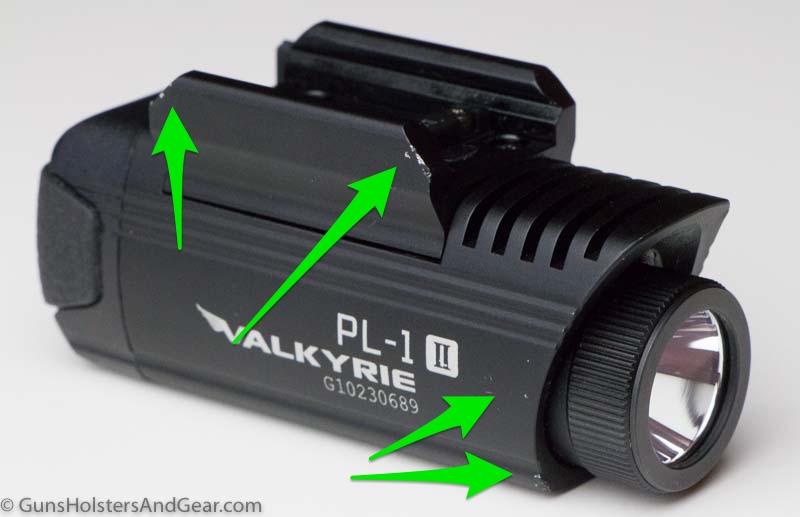
A number of dings were obvious on the flashlight body from the repeated impacts with the concrete. This is to be expected and has been seen in every flashlight I have tested. These all appeared superficial. You can see some of the damage in the above photo.
Water Resistance
Olight claims an IPX6 resistance to intrusion which is fairly typical for weapon-mounted lights. This means it offers no protection against solid particle intrusion (like dust and sand) and only spray resistance to water.
It is not rated for immersion into water. In other words, it should be fine if you are caught in the rain, but don’t expect it to work if you decide to play Navy SEAL and go swimming with it.
I have not yet devised a repeatable test for non-immersion water resistance, so I take Olight at its word on the water resistance.
Final Thoughts
I had my doubts about this light when I started my testing of it, but by the end, I was convinced that it was a good choice worthy of consideration on your defensive handgun. The light proved rugged, passing every test I threw at it and looked pretty good by the end of the evaluation. It is a worthy upgrade to the original PL 1 Valkyrie.
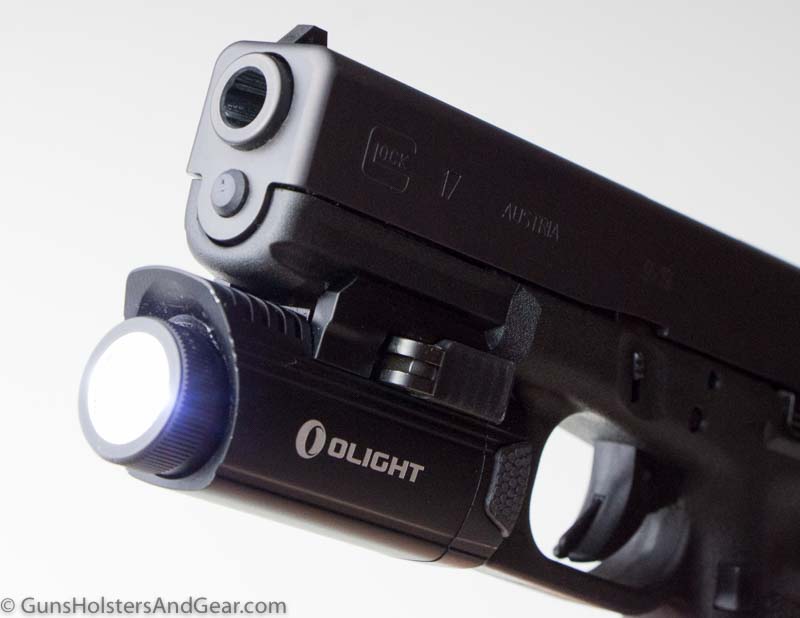
My only concerns about the light are twofold. First, it does not fit all compact pistols, so make sure you test the light prior to buying or make sure you hold onto your receipt in case you need to return it. Secondly, the activation controls (momentary versus constant on) are not ideal based on my training. They may work great for you.
If neither of those two concerns are a problem for you, then this light may be for you. It looks better than most other weapon lights and has the muscle to back it up. You can pick one up through Amazon here. Also, you can get one with a rechargable Li-ion battery and charger for just a few dollars more here.
Last Update: August 21, 2021
Disclaimer
As I’ve previously observed, there are too many “reviews” floating around the internet that are literally purchased advertising. This is not one. As with my other reviews, I fully disclose all of the information surrounding this review along with all possible biases so you can make your own decisions regarding the veracity of the details I provide in this article.
No monies were exchanged, offered, accepted or solicited for the publication of this review. I have no financial interest in Olight or any other flashlight company.
Olight is not an advertiser, nor are we in any talks for them to be one. I do not accept advertising on this site.
Olight provided this flashlight free of charge for me to evaluate. No strings were placed on this review, and no promises of a “good” or positive review were made.
GunsHolstersAndGear.com is a for-profit website. I do not charge readers a dime to access the information I provide.
Some of the links on this page and site are affiliate links to companies like Amazon and Palmetto State Armory. These links take you to the products mentioned in the article. Should you decide to purchase something from one of those companies, I make a small commission.
The links do not change your purchase price. I do not get to see what any individual purchases.
If you have any questions or concerns, please drop a note in the comments section below.
TL;DR
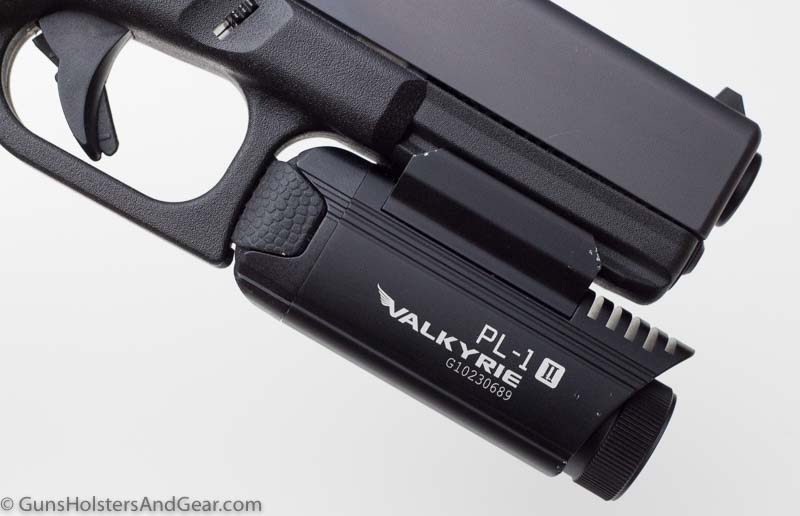
The Olight PL-1 II Valkyrie is a weapon mountable white light that uses a 450 lumen LED and single CR-123A battery to deliver almost a full hour of bright light before dropping past the 50% output threshold in my testing. The light passed my drop testing and range testing without a single problem.
With some small guns, the light may be too large, but it should fit any full size handgun with an accessory rail. It compares very favorably with Streamlight and other brands while staying extremely affordable. It can be purchased from Amazon by clicking here.
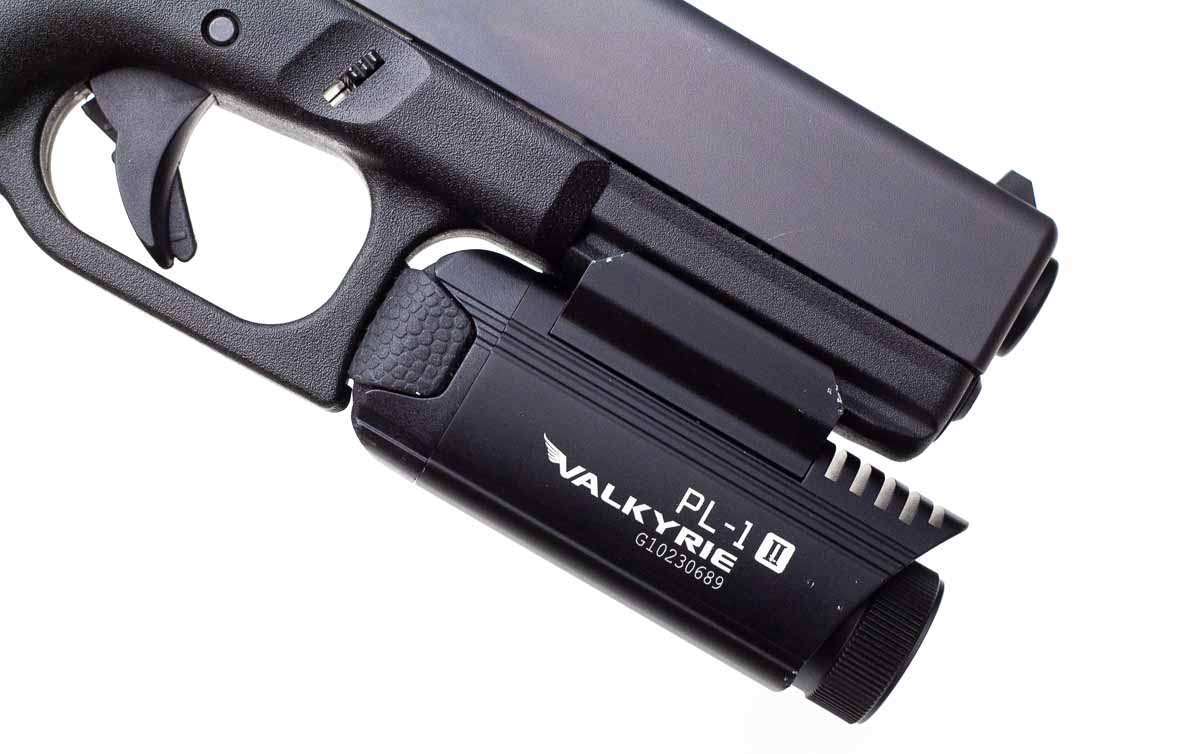
8 replies on “Olight PL-1 II Valkyrie Review”
Great review. Extremely thorough and well thought out. I really appreciate the transparency and honesty and wish that were more common in online reviews.
Thanks for the feedback and compliments. I really appreciate it!
-Richard
Any ideas on holster compatibility?
I am not aware of any holsters that are made to be compatible with this light. However, I know there are a variety of Kydex shops that are often willing to make a custom build for you.
-Richard
I personally have this light. It fits in my Galco owb holster the same as with my TLR1. Also I have a paddle holster from imi that fits it as well. It doesn’t really protrude out past the dimensions of the pistol minus of course the barrel as it does extend past the barrel. Since it is slimmer I’ll call it, than a tr1 or x300 it will fit in holster they can fit in from what i cab tell
here is my Galco with the light.
https://uploads.disquscdn.com/images/257c688ebcb745f832e977a3b16b1b64a675284484f94a1bd6506768eedfd681.jpg have seen.
One particular feature on this light that I find that gives it an advantage over some of its more expensive competitors, like Stream light, is the fact that you can remove and replace the battery without having to remove the light from the weapon. This is a feature which would be extremely handy in an emergency situation, such as emergency self defense. This gives you the ability to change the battery extremely quickly simply by removing the front bezel, dumping out the old battery, dropping in the new one in and then replacing the bezel. Granted, in a life or death situation, you may not have the time to change the battery, no matter what, but still, given the fact that you can change the battery without removing the light from the weapon, I think is excellent feature.
This is another kind of feature I would like to see covered in your reviews.
By the way I thought your review of this light was excellent.
Which Safariland Retention Duty holsters for Glock 22 with this light are compatible?
Hi Robert,
According to Safariland, the company does not make any holsters that are designed to fit pistols equipped with Olight products. Sorry the news isn’t better.
-Richard